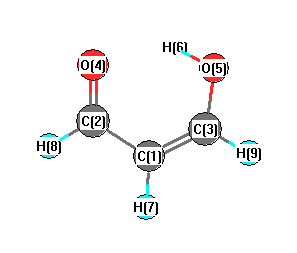Vibrational Frequencies calculated at CID/6-31G
| Mode Number |
Symmetry |
Frequency
(cm-1) |
Scaled Frequency
(cm-1) |
IR Intensities
(km mol-1) |
Raman Act
(Å4/u) |
Dep P |
Dep U |
|---|
| 1 |
A' |
3625 |
3390 |
75.28 |
|
|
|
| 2 |
A' |
3316 |
3101 |
10.55 |
|
|
|
| 3 |
A' |
3290 |
3077 |
1.55 |
|
|
|
| 4 |
A' |
3135 |
2932 |
84.07 |
|
|
|
| 5 |
A' |
1757 |
1643 |
152.12 |
|
|
|
| 6 |
A' |
1684 |
1575 |
324.45 |
|
|
|
| 7 |
A' |
1518 |
1420 |
29.77 |
|
|
|
| 8 |
A' |
1474 |
1378 |
31.27 |
|
|
|
| 9 |
A' |
1455 |
1361 |
41.90 |
|
|
|
| 10 |
A' |
1312 |
1227 |
149.30 |
|
|
|
| 11 |
A' |
1139 |
1065 |
61.39 |
|
|
|
| 12 |
A' |
1002 |
937 |
107.78 |
|
|
|
| 13 |
A' |
914 |
855 |
10.83 |
|
|
|
| 14 |
A' |
500 |
468 |
25.62 |
|
|
|
| 15 |
A' |
273 |
255 |
4.52 |
|
|
|
| 16 |
A" |
1071 |
1002 |
9.69 |
|
|
|
| 17 |
A" |
1023 |
956 |
1.43 |
|
|
|
| 18 |
A" |
804 |
752 |
88.50 |
|
|
|
| 19 |
A" |
799 |
747 |
192.06 |
|
|
|
| 20 |
A" |
411 |
384 |
3.29 |
|
|
|
| 21 |
A" |
242 |
226 |
4.44 |
|
|
|
Unscaled Zero Point Vibrational Energy (zpe) 15371.7 cm
-1
Scaled (by 0.9352) Zero Point Vibrational Energy (zpe) 14375.6 cm
-1
See section
III.C.1 List or set vibrational scaling factors
to change the scale factors used here.
See section
III.C.2
Calculate a vibrational scaling factor for a given set of molecules
to determine the least squares best scaling factor.
